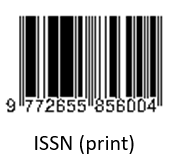Study of Nickel Extraction Process from Spent Catalysts with Hydrochloric Acid Solution: Effect of Temperature and Kinetics Study
(1) Department of Chemical Engineering, Parahyangan Catholic University
(2) Department of Chemical Engineering, Parahyangan Catholic University
(3)
(4) PT. Petrokimia Gresik
(5) Research Unit for Mineral Technology, Indonesian Institute of Sciences (LIPI)
(6) Department of Chemical Engineering, Universitas Gadjah Mada
(7)
(*) Corresponding Author
Abstract
As one of the hazardous and toxic solid wastes, spent catalysts need to be treated before the waste is discharged into the environment. One of the substances that need to be removed from the spent catalysts is the heavy metal ions and/or compounds contained therein. The method that can be applied is the extraction method using an acid solvent. In this study, the extraction process was carried out on spent catalysts samples from PT. Petrokimia Gresik. The focus of the study is on nickel extraction by varying the temperature in the range of 30–85 oC. A 1 M hydrochloric acid (HCl) solution was used as a solvent while the extraction process was 120 minutes. The experimental results show that the maximum nickel recovery of 14.70% can be achieved at a temperature of 85 oC. Kinetic studies were carried out using two kinetic models. The results of both models evaluation on the research data show that the lump model gives better results than the shrinking core model. The average error percentage of the lump model is smaller than the shrinking core model. It indicates that the extraction process was controlled by the diffusion step through the ash layer in the solid and chemical reactions simultaneously.
Full Text:
PDFReferences
M. Marafi dan A. Stanislaus, “Waste Catalyst Utilization: Extraction of Valuable Metals from Spent Hydroprocessing Catalysts by Ultrasonic–Assisted Leaching with Acids.” Industrial & Engineering Chemistry Research, 2011, 50: 9495–9501.
P.K. Parhi, K.H. Park, G. Senanayake, “A kinetic study on hydrochloric acid leaching of nickel from Ni–Al2O3 spent catalyst.” Journal of Industrial and Engineering Chemistry, 2013, 19: 589–594.
J. Ramos–Cano, G. González–Zamarripa, F.E. Carrillo–Pedroza, M. de J.Soria–Aguilar, A. Hurtado–Marcías, A. Cano–Vielma, “Kinetics and statistical analysis of nickel leaching from spent catalyst in nitric acid solution.” International Journal of Mineral Processing, 2016, 148: 41–47.
W. Mulak, B. Miazga, A. Szymczycha, “Kinetics of nickel leaching from spent catalyst in sulphuric acid solution.” Int. J. Miner. Process, 2005. 77: 231–235.
O. Levenspiel, Chemical Reaction Engineering. 3rd Edition, New York: John Wiley & Sons, Inc., 1999.
O.S. Ayanda, F.A. Adekola, A.A. Baba, O.S. Fatoki, B.J. Ximba, “Comparative Study of the Kinetics of Dissolution of Laterite in some Acidic Media.” Journal of Minerals & Materials Characterization & Engineering, 2011, 10(15): 1457–1472.
K.C. Wanta, F.H. Tanujaya, R.F. Susanti, H.T.B.M. Petrus, I. Perdana, W. Astuti, “Studi Kinetika Proses Atmospheric Pressure Acid Leaching Bijih Laterit Limonit Menggunakan Larutan Asam Nitrat Konsentrasi Rendah.” Jurnal Rekayasa Proses, 2018, 12(2): 77–84.
K.C. Wanta., W. Astuti, I. Perdana, H.T.B.M. Petrus, “Kinetic Study in Atmospheric Pressure Organic Acid Leaching: Shrinking Core Model versus Lump Model.” Minerals, 2020, 10: 1–10.
H.S. Fogler, Element of Chemical Reaction Engineering. 4th Edition, New Jersey: Prentice Education, Inc., 2006.
T. Havlík, Hydrometallurgy. Cambridge: Woodhead Publishing Limited, 2006.
DOI: https://doi.org/10.24071/ijasst.v3i2.3606
Refbacks
- There are currently no refbacks.
Publisher : Faculty of Science and Technology
Society/Institution : Sanata Dharma University

This work is licensed under a Creative Commons Attribution 4.0 International License.











